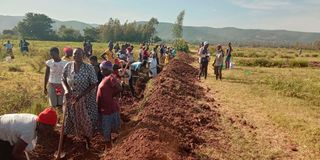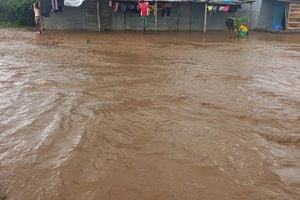Flood victims dig trenches, plant bamboos to protect homes from flooding

Residents of Chuowe in Rachuonyo North dig trenches to control floods.
What you need to know:
- In lower parts of Rachuonyo North, Homa Bay County, hundreds of families get displaced whenever heavy rains pound the region.
Kenya usually experiences heavy rains between March and May. During this time, farmers in some parts of the country are normally busy cultivating their land and planting.
In other areas, however, the long rains come with a lot of challenges. In lower parts of Rachuonyo North, Homa Bay County, hundreds of families get displaced whenever heavy rains pound the region.
The most affected areas, which are next to the outlet of River Miriu, include Chuowe, Kobala and Kobuya in Wan’ Chieng’ ward.
As it rains upstream, the river bursts its banks and floods homes and farmlands. For years, the affected families, which normally move out of their homes and live in schools, churches and health facilities on higher grounds, have depended on the government for relief food. And whenever government officials visit the families in camps, they always promise a lasting solution to the flooding menace, but fail to deliver.
The community has also petitioned the National Assembly and other relevant state agencies to stop the annual flooding crisis.
Part of the proposals to curb the flooding menace in the region is to construct dykes along the river, dredge the river bed and expand its capacity to hold large volumes of water, and channel it to Lake Victoria.
Residents said they have waited for too long (more than four years after presenting the petition) for the government to respond.
And as the rainy season approaches, some residents are worried that they will leave their homes like they have did in previous years to go and live in crowded camps.
However, some locals are determined to change the narrative and are optimistic that their homes will not be flooded.
The residents have teamed up to dig trenches around areas that let in water to their villages. The trenches are meant to redirect water from River Miriu to Lake Victoria.
One of the locals leading the project is Willis Omullo, a flood victim and the leader of Aluor Makare, a community-based organisation that deals with environmental conservation.
Mr Omullo said locals in the affected areas decided to help themselves after the government failed to fulfil its promise of building dykes and dredging River Miriu.
Last year, the region experienced floods twice. And as the impacts of climate change continue to intensify, there is concern that more floods will hit Rachuonyo. Every week, at least 200 women and men dig trenches in areas they have identified as points where water from the river gets into their homes. Soil from the trenches is used to block channels that allow water to flow into homes.
Mr Omullo said perennial flooding in the region needs a multispectral approach, with the national and county governments alongside community members and the private sector coming together to address the problem.
“Unfortunately, the government has failed to respond to our cries. We decided to take it upon ourselves to save our families and property from imminent flooding that is coming between March and May,” he said.
Mr Omullo said heavy rainfall has a lot of social and economic impacts.
“Some of the people affected by floods on an annual basis have developed mental health problems because of the challenges they face. We have been waiting for a permanent solution but nothing seems to come from the government,” he said.
Recently, the residents were trained by officials from Kenya Red Cross on disaster risk reduction and management.
They were also told that they could prevent flooding in their homes by digging trenches.
“We have intentions of building gabions to further reduce flooding. It may not be a permanent solution but we believe it will have an impact on many households,” he said.
Besides physical structures, the community has also regreened eroded areas by planting bamboo seedlings, which they obtained from the Kenya Forest Research Institute.
This is meant to rehabilitate the degraded areas.
Kenya Red Cross Coordinator Samuel Omondi told Climate Action that the agency trained the community on disaster risk reduction before the project started. The agency also provided the locals with digging tools such as hoes and shovels.
“The residents dug waterways to prevent flooding,” he said.
Mr Omondi added that families are also digging trenches around their houses besides the large waterways next to the river.
“These were among the solutions proposed at the meeting. We are looking forward to engaging the county government so it can involve contractors in the dredging of River Miriu,” the official said.
However, Mr Clifford Omondi, a climate change expert, has warned that the project is not sustainable and may not protect homes from floods.
He said it may be a short term measure, which residents should not rely on.
He explained that diversion of water should be done by experts, who use professional tools unlike Wang’ Chieng’ residents, who are doing it manually.
The expert said water has channels that can only be changed by professionals.
“The people there are likely to create new ways for water to get into their villages. They may be thinking that they are blocking water from moving to their homes when in reality they are causing more damage, and thus floods may affect areas that were initially not exposed,” he said.
Mr Omondi said the government should move with speed and help the families.
georgeodiwuor04@gmail.com

